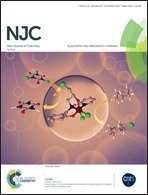A cool and high salt-tolerant ionic liquid matrix for preferential ionization of phosphopeptides by negative ion MALDI-MS†
Abstract
Matrix-assisted laser desorption/ionization mass spectrometry (MALDI-MS) is commonly used to characterize peptides and proteins. However, MALDI-MS analysis of phosphorylated peptides remains a challenge because of their low ionization efficiency. In this study, an ionic liquid matrix consisting of 1,1,3,3-tetramethylguanidium (TMG) and 2,4,6-trihydroxyacetophenone (THAP) was optimized for preferential ionization of phosphopeptides in the negative ion mode of MALDI-MS. The results indicate that the ionic liquid matrix with a TMG-to-THAP molar ratio of 3 : 1 showed the best performance for phosphopeptide analysis; this matrix was denoted as G3THAP. Furthermore, the addition of phosphoric acid (PA) to G3THAP significantly reduced the background noise because PA competes with the phosphate group of the phosphopeptide to capture alkali-ions. The resultant matrix denoted as G3THAP/PA showed great reproducibility and significantly improved the detection intensity of phosphopeptides at high salt concentrations. The selective analysis of phosphopeptides in peptide mixtures and in proteolytic digests by negative ion MALDI-MS was also demonstrated and compared to the results obtained using 3-aminoquinoline (3-AQ)/α-cyano-4-hydroxycinnamic acid (CHCA)/ammonium dihydrogen phosphate (ADP) and 2,5-dihydroxybenzoic acid (DHB)/PA matrices. In general, G3THAP/PA is a cool and high salt-tolerant ionic liquid matrix for the preferential ionization of phosphopeptides by negative ion MALDI-MS.



 Please wait while we load your content...
Please wait while we load your content...